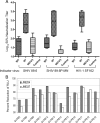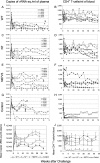Removal of a single N-linked glycan in human immunodeficiency virus type 1 gp120 results in an enhanced ability to induce neutralizing antibody responses
- PMID: 17959660
- PMCID: PMC2224603
- DOI: 10.1128/JVI.01691-07
Removal of a single N-linked glycan in human immunodeficiency virus type 1 gp120 results in an enhanced ability to induce neutralizing antibody responses
Abstract
Glycans on human immunodeficiency virus (HIV) envelope protein play an important role in infection and evasion from host immune responses. To examine the role of specific glycans, we introduced single or multiple mutations into potential N-linked glycosylation sites in hypervariable regions (V1 to V3) of the env gene of HIV type 1 (HIV-1) 89.6. Three mutants tested showed enhanced sensitivity to soluble CD4. Mutant N7 (N197Q) in the carboxy-terminal stem of the V2 loop showed the most pronounced increase in sensitivity to broadly neutralizing antibodies (NtAbs), including those targeting the CD4-binding site (IgG1b12) and the V3 loop (447-52D). This mutant is also sensitive to CD4-induced NtAb 17b in the absence of CD4. Unlike the wild-type (WT) Env, mutant N7 mediates CD4-independent infection in U87-CXCR4 cells. To study the immunogenicity of mutant Env, we immunized pig-tailed macaques with recombinant vaccinia viruses, one expressing SIVmac239 Gag-Pol and the other expressing HIV-1 89.6 Env gp160 in WT or mutant forms. Animals were boosted 14 to 16 months later with simian immunodeficiency virus gag DNA and the cognate gp140 protein before intrarectal challenge with SHIV89.6P-MN. Day-of-challenge sera from animals immunized with mutant N7 Env had significantly higher and broader neutralizing activities than sera from WT Env-immunized animals. Neutralizing activity was observed against SHIV89.6, SHIV89.6P-MN, HIV-1 SF162, and a panel of subtype B primary isolates. Compared to control animals, immunized animals showed significant reduction of plasma viral load and increased survival after challenge, which correlated with prechallenge NtAb titers. These results indicate the potential advantages for glycan modification in vaccine design, although the role of specific glycans requires further examination.
Figures








References
-
- Allaway, G. P., K. L. Davis-Bruno, G. A. Beaudry, E. B. Garcia, E. L. Wong, A. M. Ryder, K. W. Hasel, M.-C. Gauduin, R. A. Koup, J. S. McDougal, and P. J. Maddon. 1995. Expression and characterization of CD4-IgG2, a novel heterotetramer that neutralizes primary HIV type 1 isolates. AIDS Res. Hum. Retrovir. 11533-539. - PubMed
-
- Amara, R. R., C. Ibegbu, F. Villinger, D. C. Montefiori, S. Sharma, P. Nigam, Y. Xu, H. M. McClure, and H. L. Robinson. 2005. Studies using a viral challenge and CD8 T-cell depletions on the roles of cellular and humoral immunity in the control of an SHIV-89.6P challenge in DNA/MVA-vaccinated macaques. Virology 343246-255. - PubMed
-
- Amara, R. R., F. Villinger, J. D. Altman, S. L. Lydy, S. P. O'Neil, S. I. Staprans, D. C. Montefiori, Y. Xu, J. G. Herndon, L. S. Wyatt, M. A. Candido, N. L. Kozyr, P. L. Earl, J. M. Smith, H. L. Ma, B. D. Grimm, M. L. Hulsey, J. Miller, H. M. McClure, J. M. McNicholl, B. Moss, and H. L. Robinson. 2001. Control of a mucosal challenge and prevention of AIDS by a multiprotein DNA/MVA vaccine. Science 29269-74. - PubMed
-
- Amara, R. R., F. Villinger, S. I. Staprans, J. D. Altman, D. C. Montefiori, N. L. Kozyr, Y. Xu, L. S. Wyatt, P. L. Earl, J. G. Herndon, H. M. McClure, B. Moss, and H. L. Robinson. 2002. Different patterns of immune responses but similar control of a simian-human immunodeficiency virus 89.6P mucosal challenge by modified vaccinia virus Ankara (MVA) and DNA/MVA vaccines. J. Virol. 767625-7631. - PMC - PubMed
-
- Back, N. K., L. Smit, J. J. De Jong, W. Keulen, M. Schutten, J. Goudsmit, and M. Tersmette. 1994. An N-glycan within the human immunodeficiency virus type 1 gp120 V3 loop affects virus neutralization. Virology 199431-438. - PubMed
Publication types
MeSH terms
Substances
Grants and funding
LinkOut - more resources
Full Text Sources
Other Literature Sources
Research Materials

